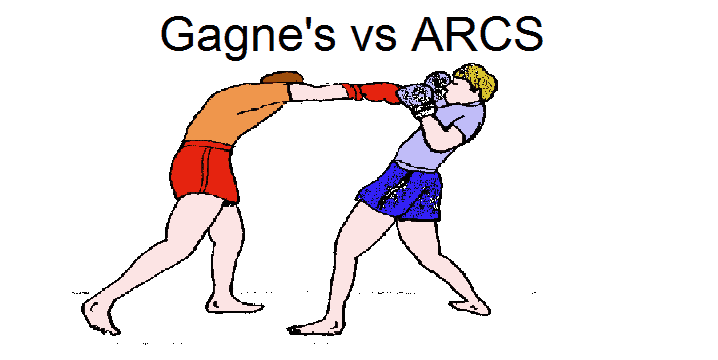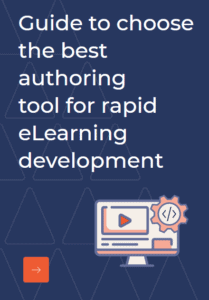Hello readers, we are back with another comparative degree post just as promised (check out the promissory note). Here we shall discuss about 2 instructional design models that have significant overlaps and subtle differences and so, the format is a bit different from that of the last post.
Introduction
Gagne’s Nine Events of Instruction was originally formulated in 1962, but the Gagne, Briggs & Wager version of 1992 is the one popularly followed. John Keller created the ARCS Model of Motivation in the year 1987 and it stands for Attention, Relevance, Confidence, and Satisfaction.
The Basics
Gagne's theoretical framework covers all aspects of learning, the focus of the theory is on intellectual skills. According to it the essential aspects of teaching are:
- presenting the knowledge or demonstrating the skill
- providing practice with feedback
- providing learner guidance.
ARCS model revolves around motivation of the learners and consists of four main categories:
- Attention - Creating/arousing interest and be able to control it to a certain extent
- Relevance - The learning has to be of use and should assist in achieving the learning goals
- Confidence - The user should be able to expect success and have the possibility to control his learning process
- Satisfaction - There should be some form of attractive returns, rewards, feedback, and self-assessment.
The Theories
Gagne’s Nine Events of Instruction outlines nine instructional events and corresponding cognitive processes as mentioned below (As mentioned in Gagné, R. M., Briggs, L. J., & Wager, W. W. (1992). Principles of instructional design (4th ed.)):
- Gaining attention (reception)
Suggested Methods: Stimulate learners with novelty, uncertainty and surprise; Pose thought-provoking questions to the learners; Have learners pose questions to be answered by other learners.
- Informing learners of the objective (expectancy)
Suggested Methods: Describe required performance; Describe criteria for standard performance; Learner establishes criteria for standard performance.
- Stimulating recall of prior learning (retrieval)
Suggested Methods: Ask questions about previous experiences; Ask learners about their understanding of previous concepts.
- Presenting the stimulus/content (selective perception)
Suggested Methods: Present vocabulary; Provide examples; Present multiple versions of the same content, e.g., video, demonstration, lecture, podcast, group work etc.; Use a variety of media to address different learning preferences.
- Providing learning guidance (semantic encoding)
Suggested Methods: Provide instructional support as needed; Model varied learning strategies; Use examples and non-examples; Provide case studies, analogies, visual images and metaphors.
- Eliciting performance (responding)
Suggested Methods: Elicit student activities and recall strategies; Facilitate student elaborations; Help students integrate new knowledge.
- Providing feedback (reinforcement)
Suggested Methods: Confirmatory feedback; Corrective and remedial feedback; Remedial feedback; Informative feedback; Analytical feedback.
- Assessing performance (retrieval)
Suggested Methods: Pretest for mastery of prerequisites; Use a pretest for endpoint knowledge or skills; Conduct a post-test to check for mastery of content or skills; Embed questions throughout instruction through oral questioning and/or quizzes; Include objective or criterion-referenced performances which measure how well a student has learned a topic; Identify normative-referenced performances which compares one student to another student.
- Enhancing retention and transfer (generalization)
Suggested Methods: Paraphrase content; Use metaphors; Generating examples; Create concept maps or outlines; Create job-aids, references, templates, or wizards
Moving on to the ARCS model which is based on psychological motivation. The stages can be broken down as below:
- Attention: can be gained either by perceptual arousal (gained by surprise, doubt or disbelief) or by inquiry arousal (stimulated by challenging problems that needed to be solved). Attention can be gained through games, role plays or anything that involves active participation, or by using contradictions,visual representations, anecdotes and biographies, humor, and also through problem-solving activities and constructive practices.
- Relevance: begins with telling the learners how the new learning will make use of existing skills, and by using analogies to relate current learning to prior experience and with learner’s interests. It also should emphasize the current value of instruction, point towards future goals and give learners the opportunity to achieve it.
- Confidence: Allow the learners to understand the goals and objectives clearly. Keep the challenges progressive and reasonable and set realistic goals. Encourage students to internalize locus of control by attributing success to themselves, and keep boosting their self-confidence from time to time.
- Satisfaction: Allow learners to use newly acquired skills in real-time settings. Surprise the learners with extrinsic rewards, and provide feedback-praise, personal attention, motivation-immediately. Avoidance of Negative Influences.
That covers both of the models briefly. ARCS Model and Gagne’s Nine Events of Instruction go hand in hand and are used by many instructional designers in congruence. The few minor differences have been marked in the Venn diagram below.
Source - https://arcsmodelofmotivationaldesign.weebly.com/arcs-vs-gagne.html
We welcome your thoughts. So, feel free to leave your comments.



